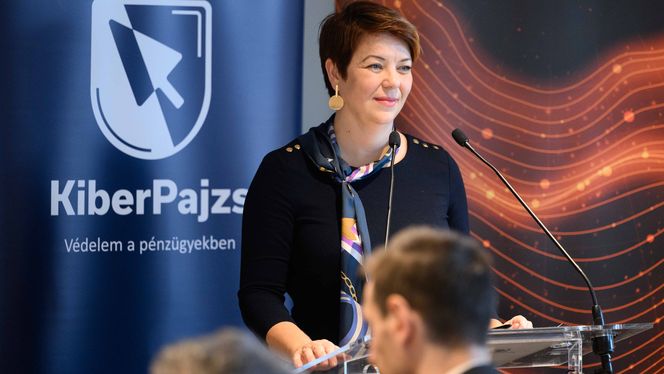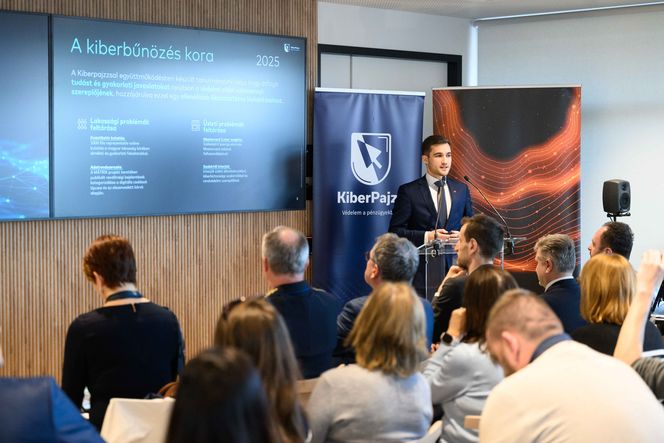TECH NEWS – A false sense of security characterizes Hungarian society regarding cybercrime: while the number of victims reaches tens of thousands annually, and financial damages have soared into the tens of billions, even the most digitally confident 18-29-year-olds score only 1.5 on a four-point cybersecurity scale, according to a recent Mastercard study. The findings will first be shared with the participants of the KiberPajzs initiative, followed by representatives of the affected industries. The rapidly escalating cybercrime threat can only be mitigated through cooperation, collaboration, and continuous knowledge sharing—KiberPajzs provides an effective framework for this effort, utilizing the conclusions of the analysis.
In Hungary, cybercrime left behind 13,000 victims and inflicted damages amounting to HUF 30 billion last year. Online commerce is particularly vulnerable: 43% of marketplace users have encountered fraud attempts, while 20% have suffered financial or data losses. Overall, nearly half (48%) of the Hungarian population has been personally affected or knows someone who has been a victim of cybersecurity fraud, yet only about a fifth (22%) consider themselves prepared to counter such threats. Among the prime targets for cybercriminals, the public sector currently faces the highest risk; threats to the healthcare industry have declined, but the technology sector has become increasingly targeted since the pandemic.
Cybersecurity Awareness: Challenges and Lessons in Digital Protection
According to a recent representative Mastercard survey, 70% of Hungarian adults who completed the study’s test are aware that banks never request card details or login credentials over the phone or via email. Nevertheless, last year saw a surge in fraud cases where victims were scammed out of more than HUF 10 million using such methods. This example underscores a key observation from cybersecurity experts: the weakest link is always the pressured or unprepared user. The best defense is up-to-date knowledge—this is precisely why the founders of the KiberPajzs initiative joined forces. Their goal is to reduce digital crime and provide protection for potential victims. Information sharing is crucial in this fight, as it empowers stakeholders with the knowledge to strengthen their defenses effectively. As a committed partner of KiberPajzs, Mastercard has contributed a recent study that provides an in-depth analysis of users’ cybersecurity awareness and the evolving tactics of cybercriminals. The aim is to identify risks, reinforce security measures, and ensure that those involved in cybersecurity have a thorough understanding of cybercrime—an area where information exchange is of paramount importance.
– Cybercrime Era 2025 is a unique and essential study that not only outlines Hungarian and regional attack trends but also provides a data-driven analysis of Hungarian users’ cybersecurity awareness and needs. By compiling this document, we aim to provide valuable information and assistance to security professionals and decision-makers within and beyond the digital payments ecosystem. I firmly believe this study will serve as a key reference point in collaborative efforts to enhance security levels, and KiberPajzs provides an especially effective and well-functioning framework for organizations dedicated to strengthening cybersecurity – emphasized Gergely Márkus, Country Manager for Mastercard Hungary and Slovenia.
The Cybercrime Era 2025 study examines the issue from an international perspective, revealing that by the end of 2024, global cybercrime-related damages could reach $9.5 trillion. A key takeaway from Hungarian user surveys is the deep gap between theoretical cybersecurity knowledge and actual digital behavior. For instance, 46% of respondents in the study’s test were unable to distinguish between legitimate messages and phishing attempts. Young adults often overestimate their security awareness due to their confidence in digital skills. While 90.5% of those aged 18-29 consider themselves difficult to deceive, their average digital security index score on a ten-question test was only 1.5 out of 4. The survey also found that the older someone is, the less confident they feel about recognizing digital fraud. However, in practice, older generations performed better in the test than younger ones.
The Fight Against Cybercrime: Collaboration and Technological Defense
Cybercriminals’ capabilities evolve in tandem with technological advancements. Automation, collaboration, outsourcing, external expertise, artificial intelligence, and information sharing—these are just some of the tools criminals use to maximize illicit profits. It is a rapidly growing “industry” where the speed of information access is critical. Effective defense requires not only ingraining safe practices into daily habits but also ensuring that up-to-date cybersecurity information reaches individual users and businesses quickly and organically through their existing social channels.
However, coordinating knowledge-sharing and uniting stakeholders is essential—this is precisely the role undertaken by the KiberPajzs Program, initiated by the Hungarian Banking Association and the Hungarian National Bank. Key participants include the Police, the National Cybersecurity Institute, the National Media and Communications Authority, the Ministry of Justice, the Financial Conciliation Board, the Regulatory Supervision Authority, the Ministry of National Economy, the Hungarian State Treasury, the National Protection Service, as well as new entrants like Szerencsejáték Zrt. and VISA. Additionally, Mastercard has contributed international expertise and a comprehensive national study to support these efforts.
– Supporting law enforcement is a universal responsibility for all organizations and individuals. Preparing for cybercrime is a collaborative effort between the government, IT, telecommunications, retail, and financial service providers. We welcome Mastercard, a renowned and significant financial player, as a new member of KiberPajzs. Their research highlights that respondents expect and appreciate cybersecurity advice from their service providers. The KiberPajzs initiative anticipates these expectations by developing new cybersecurity content and solutions to enhance user education – Dr. Levente Kovács, Secretary General of the Hungarian Banking Association.
– We believe that user vulnerabilities often stem not from technological limitations but from a lack of knowledge and awareness. Law enforcement experiences and crime statistics confirm this: while 80% of respondents consider two-factor authentication neither too complex nor time-consuming, far fewer use it than would be advisable. Through joint efforts, we aim to drive improvements in this area – added Sándor Töreki, Deputy National Police Chief of Criminal Investigations.
– On online shopping, payment, and service platforms, user-friendly interfaces, mandatory security features, and safe operations must work together to protect users. Built-in solutions are needed to enhance security without complicating usability—for instance, by detecting fraudulent transactions in the background and either blocking them or issuing warnings to consumers. Initiatives like KiberPajzs play a vital role in cybersecurity defense, as does leveraging the most advanced technologies – stated Lajos Szabó, Director of the National Cybersecurity Institute.
Cybersecurity Developments and OTP Bank’s Defense Achievements
In Europe, trends observed over the past year, emerging cybercrime tactics, and the increasing number and sophistication of attacks on domestic IT systems have highlighted the need to enhance previously implemented security measures and introduce necessary improvements.
– Banking systems are secure. Thanks to OTP Bank’s security measures and its collaboration with law enforcement and card networks, financial fraud losses affecting customers have been significantly reduced. In 2024, OTP Bank reported a 32% decrease in fraud-related damages compared to 2023. Additionally, in terms of prevented losses, we managed to safeguard more than three times the amount of funds in customer accounts compared to the previous year – stated Gábor Bucsek, Head of OTP Bank’s Security Directorate.
The KiberPajzs alliance focuses on several critical areas, including education, raising situational awareness in high-risk online activities, awareness campaigns, partnerships, real-time reporting and advisory channels, and victim assistance. Beyond changing public attitudes towards cybersecurity, another key objective is strengthening Hungary’s cybersecurity ecosystem by establishing “Cyber Islands” collaboration hubs, where cybersecurity experts, corporations, startups, and students can work together to develop solutions for emerging cyber threats.
The Study’s Methodology
The Cybercrime Era 2025 study is based on four sources: Mastercard’s national representative survey, processed law enforcement reports, Mastercard’s industry analysis, and interviews with IT security leaders and experts. This comprehensive and essential research provides an in-depth overview of the current trends and nature of cybercrime.



















Leave a Reply